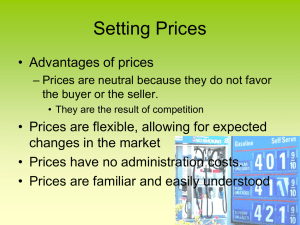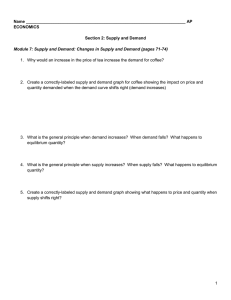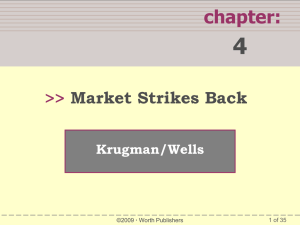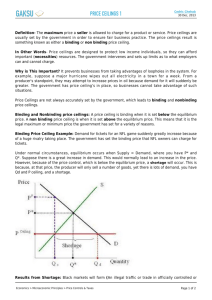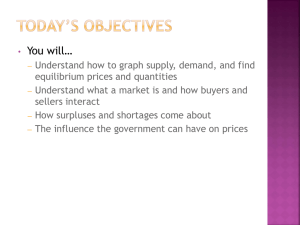Price Controls in the Product Market
advertisement
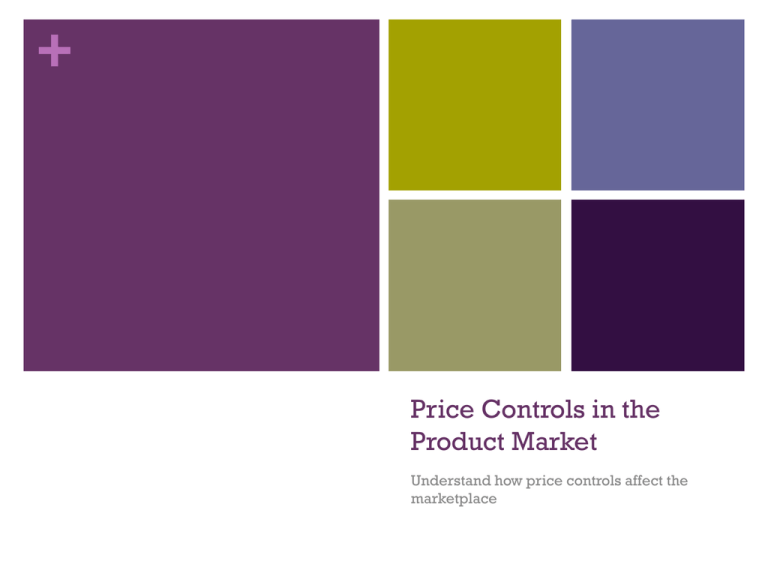
+ Price Controls in the Product Market Understand how price controls affect the marketplace + Rent Control in NYC… Jimmy McMillan + Government Intervention in the Marketplace is Always Controversial But why is that??? + Price Ceiling • A maximum price sellers are allowed to charge for a good or service • Government imposed restriction on the free market • Ceilings are effective below equilibrium • Creates a shortage in the housing market—or whatever market a ceiling is placed within • Quite often lead to inefficiency in the marketplace + Price Ceilings Creating Inefficiency Inefficient Allocation to Consumer: people who are willing and able to buy the good/service at equilibrium price don’t get it and those who care relatively little about acquiring the good/service and who are only willing to pay a lower price do get the good/service...leads to missed opportunities Wasted Resources: people expend money, time, and effort to cope with shortages caused by the price ceiling…missed opportunities Inefficiently Low Quality: the goods being offered under a shortage are not of the high quality that buyers are expecting from the marketplace + Results of Price Ceilings Persistent shortage of the good/service affected Inefficiency arising from the persistent shortage Emergence of black markets Allocation, resources, quality The illegal buying or selling of a good/service—either because the good is illegal or because it is illegal to sell above a certain price Then WHY??? • In theory, some people benefit: gives much cheaper housing to people that couldn’t afford their rent otherwise + State Minimum Prices + Price Floor Minimum price buyers are required to pay for a good/service Government restriction on the price of a good that can be charged in the marketplace Floors are effective above equilibrium • Creates a surplus in the market of whatever good it is imposed on • Frequently, the government will buy up the surplus + Price Floors Create Inefficiency Inefficiently Low Quantity: Reduced quantity demanded (surplus)—sellers cannot sell if buyers will not buy. Therefore, a price floor reduces the the quantity of a good bought and sold below market equilibrium So, both floors and ceilings reduce the quantity of goods being bought and sold Inefficient Allocation Among Sellers: Those who would be willing to sell the good at the lowest price are not always the producer who can manage to sell it Wasted Resources: Wasted supply of the good produced, time, effort and energy Inefficiently High Quality: The goods offered for sale in the marketplace are often high-quality and sold at a high price, although buyers would prefer low-quality, low-priced goods Illegal Activity: Creates incentive for people to behave illegally in the marketplace + Results of Price Floors Persistent surplus of the good Inefficiency arising from Low quantity, poor allocation, waste, high quality, illegal activity Then, WHY??? • Sellers stand to benefit from the minimums placed on the sale prices of their goods…agriculture industry in the US + When Floors and Ceilings are Irrelevant If a price floor is below equilibrium price If a ceiling is above equilibrium price Both of these scenarios would render the price control irrelevant and ineffective in the marketplace For example: Market for cheese…
